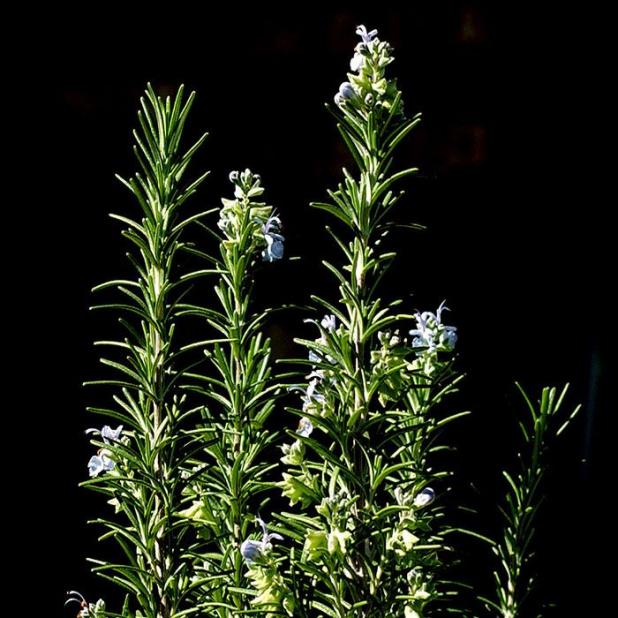
Rosemary is a perennial herb that provides attractive flowers as well as flavorful stems and leaves.
—LSU AgCenter Photo/Mark Claesgens
Flavorful herbs are easy to grow
Convincing a group of kids that herbs are important is easy. Just mention pizza (oregano), spearmint gum (spearmint), dill pickles (dill) and peppermint candy (peppermint), and you’ll have them all agreeing that herbs are great. Adults generally need no such convincing because most of us know that herbs are vital to flavor many dishes. More gardeners should also know that herbs are easy to grow and can add flowers, fragrance and texture to the landscape.
Louisiana gardeners can successfully grow a wide variety of herbs, although some, such as French tarragon and lavender, often succumb to our hot, wet summers despite careful culture. When selecting which herbs you want to grow in your garden, consider what you commonly cook with. Look at the herbs in your kitchen cabinet and start off growing those types of herbs. Be very careful if you decide to grow and use medicinal herbs. You must know exactly what you are doing. Used improperly, some medicinal herbs can be quite toxic.
Most herbs require at least four to six hours of direct sun a day and excellent drainage. Raised beds are best for most herbs. If raised garden beds are not practical for you and your drainage is poor, try growing herbs in containers.
Locate your culinary herb-growing area as close to the kitchen as possible so they are convenient to use while you are cooking. If you have to walk all the way across the yard to harvest them, they’ll likely be underutilized.
For growing purposes in Louisiana, herbs can be loosely grouped into cool-season annuals and warm-season annuals that live for one season and then die and perennials, which live for several years.
Cool-season herbs can tolerate normal winter freezes. They should be seeded or transplanted September through early February. You can plant transplants now because we are late in the cool season at this point, and you can still expect to get acceptable harvests in May or early June. Excellent herbs to plant now include parsley, cilantro or coriander, celery, dill, chicory, fennel, borage, arugula and chervil.
Terrific warm-season annual herbs are basil in all its myriad forms and flavors, sesame and perilla. They can be seeded in pots now and transplanted into the garden as soon as they are big enough. Purchased transplants could also be planted in late March and through the summer.
Some perennial herbs that do well here are mints, lemon verbena, lemon balm, rosemary, Mexican tarragon, burnet, sorrel, society garlic, garlic chives, oregano, monarda, catmint, anise hyssop, mountain mint, French bay, pineapple sage and rue. All the perennial herbs can be planted now and through spring using transplants available at local nurseries.
Thyme, sage, catnip, lavender and many of the scented geraniums are perennial herbs that require excellent drainage to survive the summer. They may be more successful when grown in containers and placed in a location that gets some afternoon shade during summer. Even grown under good conditions, they tend to be short lived and often succumb to root and stem rots in the hot, wet late-summer season.
Harvest herbs frequently and regularly, being careful not to deplete all the plant’s foliage. Take no more than one third of the total foliage at any one time. The flowers of herbs may also be used as a garnish or to flavor dishes.
Sometimes the herb garden can be too productive. At these times, it is important to know how to preserve the extras. Most herbs — but not basil — can be kept for about a week after harvesting in plastic bags in the vegetable storage section of your refrigerator or with their stems placed in small glasses of water. Ways to preserve them for longer periods are drying and freezing.
To dry herbs, harvest with the stems long enough to easily tie them together. Next, rinse them with water and blot dry. Make small bundles of about three to five stems held together with rubber bands and insert an unbent paper clip or S-shaped piece of wire to make a hook. Hang the bundles in a cool, dry place indoors with good air circulation. Another way to dry herbs is to lay leaves or short sprigs on a cookie sheet lined with paper towels. When the herbs are thoroughly dry, store them in tightly sealed containers labeled with the name of the herb or herb blend and the date. You can leave the leaves whole or crumble them to the desired fineness.
To freeze herbs, harvest, rinse and blot dry. Remove leaves from woody stems and chop them finely before freezing. Place chopped herbs in a freezer bag, spreading them out in a one-half-inch layer. This makes it easier to break off usable pieces later when the herbs are frozen solid. Force out as much air as possible, seal the bag and freeze. Be sure to label the bag with the name of the herb because chopped frozen herbs tend to look the same.
For more information on growing and using herbs, I recommend “Southern Herb Growing” by Madalene Hill and Gwen Barclay, Shearer Publications.
